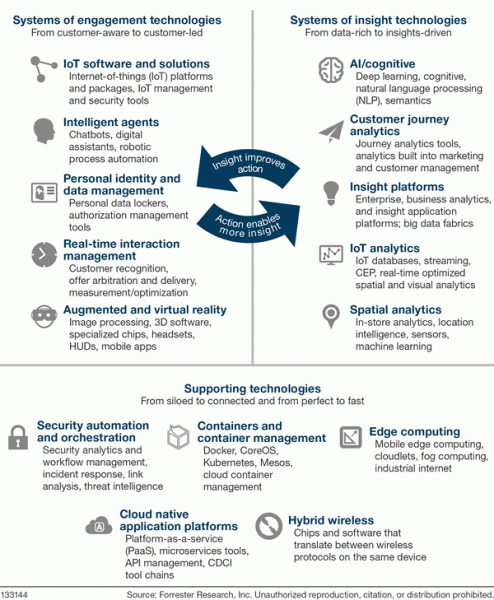Forrester’s Top Emerging Technologies To Watch: 2017-2021
Think back just a few years — social, mobile, cloud, and big data ruled the emerging technology landscape. Business and technology management executives wondered what big data meant, when the cloud would disrupt their companies, and how to engage effectively on social channels. In 2016, Hadoop turned 10, the cloud has been around even longer, and social has become a way of business and life. So what's next?
As a refresh to my 2014 blog and report, here are the next 15 emerging technologies Forrester thinks you need to follow closely. We organize this year's list into three groups — systems of engagement technologies will help you become customer-led, systems of insight technologies will help you become insights-driven, and supporting technologies will help you become fast and connected.

Why these 15? You might have noticed a few glaring omissions. Certainly blockchain has garnered a lot of attention; and 3D printing is on most of our competitors' lists. The answer goes back to being customer-led, insights-driven, fast, and connected. Those of you that follow our research will recognize these as the four principles of customer obsessed operations. The technologies we selected will have the biggest impact on your ability to win, serve, and retain customers whose expectations of service through technology are only going up. Furthermore, our list focuses on those technologies that will have the biggest business impact in the next five years. We think blockchain's big impact outside of financial services, for example, is further out so it didn't make our list, even though it is important. Maybe by 2018, when I update our list next.
Since I don't have room here for details about all of our technologies, I'll focus on five that we think have the potential to change the world. That's one-third of our list by the way – which means a lot of change is coming; it's time to make your technology bets.
- IoT software and solutions bring customer engagement potential within reach. Theses software platforms and solutions act as a bridge between highly specialized sensor, actuator, compute, and networking technology for real-world objects and related business software. This technology gives firms visibility into and control of customer and operational realities. By 2021, technology for specific use cases will be mature, but protocol diversity, immature standards and the need for organizational changes will still stymie or delay many firms. Want more info? Schedule an inquiry wtih my colleauge Frank E. Gillette.
- Intelligent agents coupled with AI/cognitive technologies will automate engagement and solve tasks. Intelligent agents represent a set of AI-powered solutions that understand users' behavior and are discerning enough to interpret needs and make decisions on their behalf. By 2021, we think that automation, supported by intelligent software agents drivng by an evolution in AI and cognitive technology will have eliminated an net 6% of US jobs. But the loss won't be uniform. There will be an 11% loss of jobs that are vulnerable and a 5% creation of jobs in industries that stand to benefit. Want more info? Schedule an inquiry with Craig Le Clair on AI in the workforce or my colleague Jennifer Wise on intelligent agents.
- Augmented reality overlays digital information and experiences on the physical world using combinations of cameras and displays. While we cover both VR and AR, we find that while a lot of attention has been placed on VR, AR has more play, for enterprises in the short term and eventually for consumers as well. By 2021, we will be fully into a transition period between separated and tightly blended physical and digital experiences in our work and lives. Want more info? Schedule an inquiry with my colleague J.P. Gownder.
- Hybrid wireless technology will eventually create connected everything. Hybrid wireless technologies are the interfaces and software that allow devices to simultaneously leverage and translate between two or more different wireless providers, protocols, and frequency bands, such as light, radio, Wi-Fi, cellular, and Sigfox. By 2021, a virtual network infrastructure will emerge to weave together wireless technologies that globally connect IoT and customer engagement platforms. Want more info? Schedule an inquiry with my colleague Andre Kindness.
To go deeper, listen to Forrester's What It Means podcast episode: The New Tech Revolution, or if you are a client, please read the report. Lastly, I want say thank you and acknowledge all of the great analysts that helped with this report. Too many to name, but here are a few (check out their blogs!) – Frank Gillette, JP Gownder, Rusty Warner, Ted Schadler, Dave Bartoletti, Andre Kindness, Jeff Pollard, Fatemeh Khatibloo, John Rymer, Brendan Witcher, Dan Bieler, Michael Facemire, Rowan Curran, Noel Yuhanna, and Tina Moffett.
